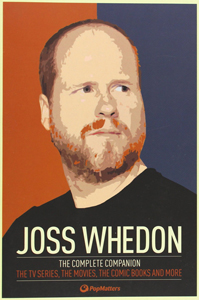In PopMatters’ “Joss Whedon: The Complete Companion” (2012), Alysa Hornick – one of the dozens of contributors – notes that Buffy didn’t excel at academics, but academics have gone crazy for her. This nearly 500-page doorstop is a case in point, as it drives home a fact that I suspected beforehand and have confirmed here: “Buffy” (which marks its 25th anniversary today) is the most academically studied TV show of all time.
And Whedon’s other works aren’t far behind, making him the most-studied TV auteur ever.
(Note to readers: This post is strictly a book review, but for my take on the controversies about Whedon’s behavior, please see my commentary from last year.)

“Joss Whedon: The Complete Companion” (2012)
Essays, analysis and interviews about “Buffy,” “Angel,” “Firefly,” “Dollhouse” and other Whedon works
Editor: Mary Alice Money
All major works covered
I have several Whedonverse essay collections on my shelves, but “Companion” is different because, as Jane Espenson (currently a writer on Whedon’s “The Nevers”) says in a blurb: “This is the biggest book I have ever seen about Joss Whedon.”
It features overviews and essays on everything authored by Whedon. The only things passed over are movies where he polished dialog and TV episodes he guest-directed. Especially now that it can be found used and cheap, I concur with Espenson: You should get this book.
“Companion” is imperfect, though. Editor Mary Alice Money (Full disclosure: She’s the aunt of my friend Todd Money) gently hints in the introduction that she got her assignment late in the process. I think this book was rushed into production to coincide with “The Avengers,” and it would not pass muster with a Grammar or Style Nazi.
While the text isn’t polished to a sheen, there’s nothing that tripped me up. (I’m reviewing the original version here; the revised edition might’ve been cleaned up.)
Some missteps
Ninety percent of the entries are quite good, but the bad ones are pretty bad. The interviews are mostly pointless, including a notably worthless chat with Espenson, oddly. (The best interview is Tim Minear’s, where he gives a good sense that he loves his career even though it consists of working on great TV shows that are quickly canceled.)
And there is one overblown, nonsensical analysis each on “Astonishing X-Men” and “Comic-Con Episode IV: A Fan’s Hope” (which Mutant Enemy produced).
“Companion’s” sections are – quite sensibly – “Buffy,” “Angel,” “Firefly,” “Dollhouse,” “Dr. Horrible,” Comics and Movies, with each getting a page count commensurate with how much of Whedon’s career has been devoted to the work.
It’s safe to say you’ll get more about Buffyverse comics here than in other collections (but keep in mind that it only goes up to 2012).

I learned from this book that Whedon wrote an arc of Marvel’s “Runaways,” a comic that has itself gone on to be a TV show. I might check that out someday, along with his one-shot “Sugarshock!”
The essays and analyses lean toward praise of Whedon’s work, although there is some criticism – mostly aimed at the expected quarters, like “Buffy” Season 7 and the early episodes of “Dollhouse.”
Hurt and helped by the industry
Surprisingly but refreshingly, several entries examine Whedon’s work not in a vacuum but rather by how it was shaped by industry push and pull. Indeed, the web-based “Dr. Horrible” came about from the writers’ strike and ended up as an example that an auteur can work outside of the network system (if you’re a big enough name).
A strong example of looking at TV as part of the real world rather than merely as a narrative is Don Tresca’s “Fantasy is Their Business, But It is Not Their Purpose.” He brilliantly argues that “Dollhouse” is a metaphor for the process of making a network TV show.
Tresca now has me convinced that Whedon deliberately used this parallel throughout the show’s run, even though I didn’t think of it before.
In “How ‘Buffy’ Changed Television,” Robert Moore gets at something I’ve suspected: “Buffy” marks the pivot-point between TV as a medium where continuity does not matter (every episode hits the reset button at the end) to a medium where it very much matters (if you miss an episode, you’ve missed something).
Narratives and fandom
Speaking of continuity, Kyle Garret’s “Failure of the Everyman” outlines how Xander’s arc runs its course before the series’ narrative does; Garret justifies my feeling that Xander’s core traits are abandoned by the writers starting with “Hell’s Bells.”
Furthering the notion that character growth is ever-present in Whedon’s shows, in “The Three Faces of Anne,” Tresca analyzes the evolution of Anne Steele, who only appears in five Buffyverse episodes yet has a complete journey of growth.
On the production side, Rhonda Wilcox’s “The Darkness of ‘Passion’ ” is a masterful analysis of the use of voiceovers, POV and framing in what I (even more proudly now) call my favorite “Buffy” episode.
Some pieces peek at fan culture, with Oz-Willow ’shipper Lily Rothman’s “I’d Very Still: Anthropology of a Lapsed Fan” making me think of those Tuesday nights of watching “Buffy,” then discussing it at The Bronze via dial-up connection.
Comparing and contrasting
Some essays, although categorized under one of the headings, compare and contrast Whedon’s works, showing for instance how he returns to the theme of an overreaching authoritative body, from the Watchers’ Council to the Alliance.
A particularly vibrant entry on Whedon’s touchstones is “ ‘Alien Resurrection’: The Script that Shaped Joss Whedon’s Career” by Raz Greenberg.
I had noticed that the crews of both the Betty and the Serenity are smugglers just getting by in The Black, but Greenberg convincingly paints “Resurrection” as something Whedon mines from in all his future work – for instance, the Ripley-Call relationship as a precursor to Buffy-Dawn.
As you can tell, there’s lots of good stuff in here, even if there are some frustratingly wasted pages on shallow interviews, and even though I’m sure Money would’ve given this another editing pass if she had more time.
This tome is big, but you should find room for “Joss Whedon: The Complete Companion” on your already crowded shelf.

